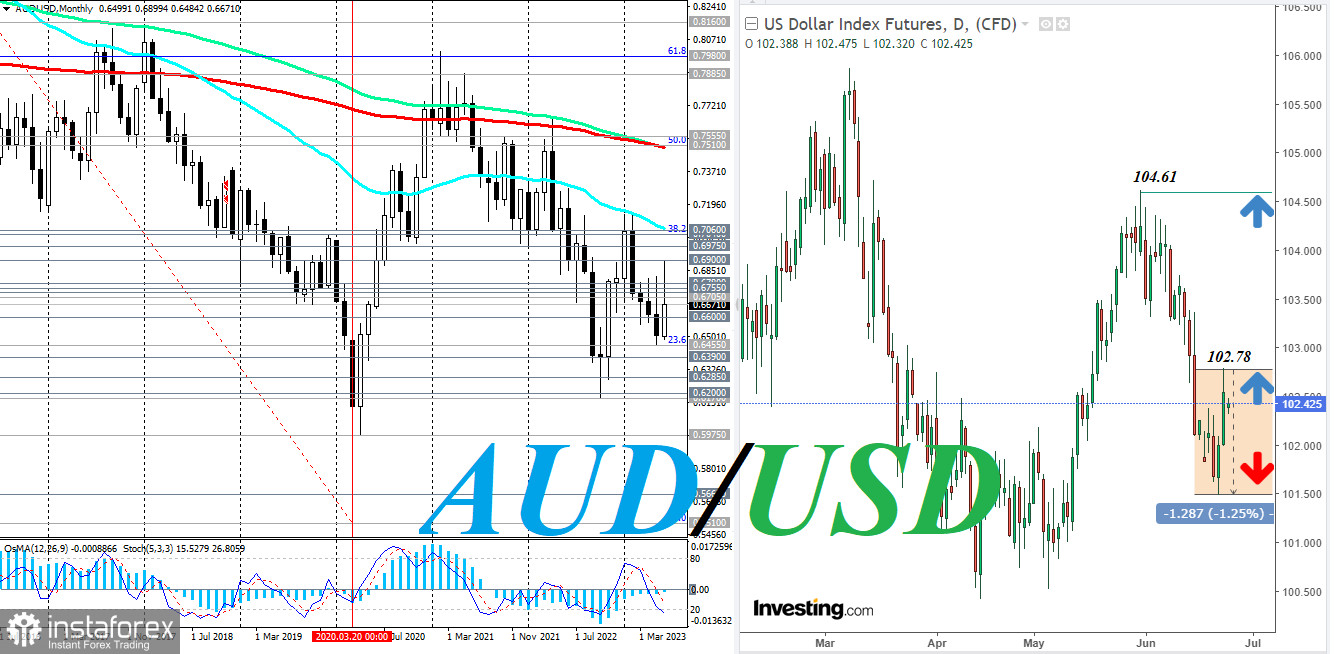
After a significant strengthening since the beginning of the month, last week became unsuccessful for the Australian dollar and disappointing for buyers of the AUD/USD pair.
The Australian dollar sharply strengthened, and the AUD/USD pair rose following the Reserve Bank of Australia's (RBA) latest meeting, where the interest rate was unexpectedly raised by 25 basis points to 4.10%. In their accompanying statement, the bank's officials noted that they made the decision in the face of ongoing inflationary pressures, which remain unacceptably high at 7.0% (RBA's target range is 2.0%–3.0%). They also did not rule out the possibility of further interest rate hikes if the economic situation warrants it and significant damage is not done to economic growth and citizen welfare.
Subsequently, the released macro statistics further boosted the Australian dollar, indicating an increase in business activity in the Australian services sector and an improvement in the national labor market. The Commonwealth Bank's Purchasing Managers' Index (PMI) for the services sector in May rose to 52.1 (compared to the previous reading of 51.8 and the neutral forecast). Additionally, employment data released by the Australian Bureau of Statistics in the middle of the month indicated a job growth of 75,900 (against a forecast of 17,500 and a previous reading of 4,300) and a 0.1% decrease in unemployment (compared to the previous reading of 3.7% and the neutral forecast).
Nevertheless, the Australian dollar weakened afterward, and the past week pushed the AUD/USD pair back to the level of 0.6670, partially offsetting the gains made during this ongoing month.
Specifically, this was influenced by Federal Reserve Chairman Jerome Powell's moderately hawkish statements during his testimony in Congress last week, where he confirmed that it would be "appropriate to raise rates again this year and perhaps two more times."
"Inflationary pressures remain elevated, and the process of returning inflation to 2% has a long way to go," said Powell, noting that the Fed understands the "challenges posed by high inflation" and is "still firmly committed to achieving the 2% inflation target."
Last weak's weak macro statistics from Australia became an additional negative factor for the AUD.
For instance, the preliminary Australian Manufacturing PMI for June came in at 48.6, remaining in contraction territory below the 50 mark, while the Services PMI adjusted from 52.1 to 50.7.
In addition, the Westpac Leading Economic Index in May dropped by 0.27% after a decrease of 0.03% in the previous month, and RBA Deputy Governor Michelle Bullock predicted an increase in unemployment to 4.5% from the current 3.6%.
The decision by the People's Bank of China last week to reduce the interest rate by 10 basis points to 3.55% also exerted pressure on the Australian dollar, indicating concerns by the Chinese central bank about the slowdown in economic growth (by the way, S&P Global recently published a report on the prospects of the Chinese economy, which stated a reduction in China's economic growth forecast for 2023).
Thus, negative fundamental factors prevailed over the positive ones, which was reflected in the dynamics of the AUD/USD with a decrease in quotes.

During today's Asian session, AUD/USD traded in a range near the 0.6675 mark, last Friday's closing price. The pressure on the pair seems to persist, creating conditions for further decline within the long-term bearish market.
On the other hand, the U.S. dollar is attempting to recover amid expectations of a rate hike at the July Federal Reserve meeting.
Fed Chair Powell will again give a speech on Wednesday, and market participants will be awaiting new signals from him regarding the near-term prospects of the U.S. central bank's monetary policy. The RBA's monetary policy meeting, dedicated to these issues, will take place on Tuesday next week. The leaders of the Australian central bank may once again resort to raising borrowing costs to combat high inflation, which may positively affect AUD.
Tomorrow (at 12:30 GMT), fresh data on the dynamics of U.S. durable goods orders will be released (a decline of 1.0% is expected after a growth of 1.1% in the previous month), followed by data on new home sales at 14:00 (here, a relative growth slowdown of 0.5% is also expected after a growth of 4.1% in April), and the consumer confidence level for June.
Weak data and data worse than expected will exert negative pressure on the U.S. dollar, which, in turn, may give the AUD/USD pair a short-term positive impulse.





















